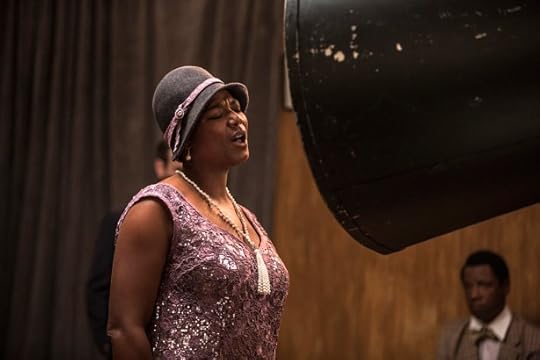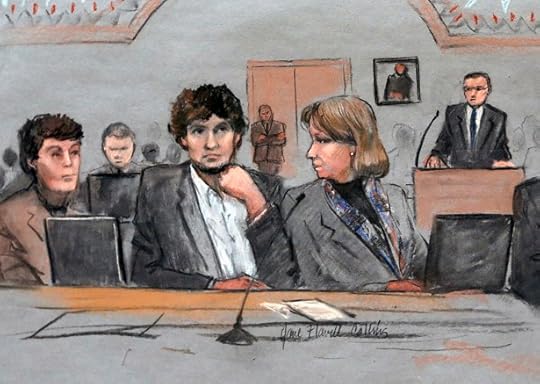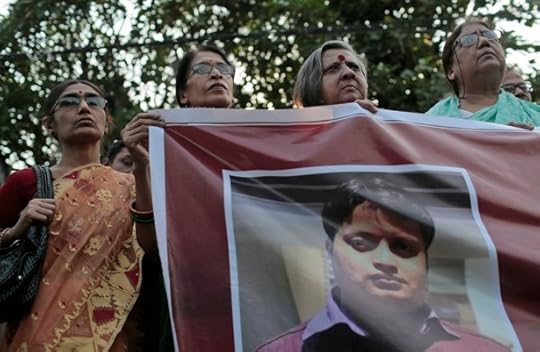Atlantic Monthly Contributors's Blog, page 431
May 16, 2015
'Egypt Is Turning Back Into Ancient Egypt'

Just under three years ago, Mohammed Morsi assumed office as Egypt’s first freely elected head of state, a milestone in the “Arab Spring” struggle for democracy. On Saturday, the same Egyptian state condemned him to die. A court in Cairo has sentenced the former president to death for conspiring with foreign militants during a prison escape in 2011. The ruling comes one month after Morsi received a separate 20-year sentence for inciting violence against protesters while in office. Egyptian authorities have detained Morsi since his overthrow in July 2013.
The sentencing triggered international outrage. Amnesty International called the verdict a “charade based on null and void procedures” and demanded Morsi’s release or retrial. Recep Tayyip Erdogan, Turkey’s president and an erstwhile supporter of Morsi, also condemned the decision.
“The popularly elected president of Egypt, chosen with 52 percent of the vote, has unfortunately been sentenced to death," he said at a rally in Istanbul.
“Egypt is turning back into ancient Egypt,” he added.
The country’s sudden and complete reversion to authoritarian rule, however, is a distinctly modern phenomenon. General Abdel Fattah Al-Sisi, Egypt’s ruler since overthrowing Morsi in July 2013, has overseen a sustained crackdown of political opposition, recriminalizing membership in the Muslim Brotherhood and imprisoning thousands of Morsi supporters. In recent months, the al-Sisi regime has sentenced hundreds of people to death, including 100 others condemned alongside Morsi on Saturday.
The country has undergone a sudden and complete reversion to authoritarian rule.Meanwhile, Morsi’s predecessor—the 87-year-old Hosni Mubarak—may soon win back his freedom. On May 8, an Egyptian court upheld a three-year sentence against the former dictator, who governed Egypt from 1981 to 2011, but said that prosecutors were considering releasing him due to time served. Mubarak’s sons Alaa and Gamal, arrested alongside their father in 2011, were released in January and have recently reappeared in public.
Mubarak gets 3 years in prison. Morsi gets referred to the Mufti for potential execution. Let this sink in for a minute.
— Dalia Ezzat (@DaliaEzzat_) May 16, 2015
The United States, once a full-throated supporter of Egypt’s fledgling democracy, has quietly acquiesced to the country’s authoritarian revival. In March, President Obama lifted an arms freeze against Egypt and told Al-Sisi that the White House would support resuming $1.3 billion in annual military aid “in the interest of U.S. national security.”
Morsi’s eventual execution is by no means assured, and his case will likely undergo a lengthy, uncertain appeals process. The next step in the process, though, has been announced. On June 2, Egypt’s Grand Mufti, the country’s maximum Sunni Muslim authority, must decide whether Morsi will be executed. In a Shakespearean twist so familiar to Egyptian politics, the Grand Mufti was originally appointed by Morsi himself.









Pixar and TV Sex: The Week in Pop-Culture Writing

Age of Reboots: How Marvel Is Killing the Popcorn-Movie
Sady Doyle | Medium
“Marvel has been racist and Marvel has been sexist, but Marvel’s most profound failing is that it just plain doesn’t care about people. Age of Ultron is the clearest demonstration yet of the problem. And you should care about this problem. Because it’s getting worse, and because you can’t get away.”

Anna Wintour and Age of Ultron: The Week in Pop-Culture Writing
An Oral History of Pixar
Clickhole
“To top it all off, Pete had an idea for a film where a man’s wife dies. Our jaws hit the floor. It was the best idea any of us had ever heard. As soon as I could stop gaping, I said, ‘Pete, I need to know what happens to the man whose wife is dead.’ Before the words even left my mouth, Pete had written the entire script for Up on a napkin.”
How Hollywood Stays White and Male
Alyssa Rosenberg | Washington Post
“So why is it so hard to make the very engine of America’s fantasies and aspirations look much like the country Hollywood hopes to inspire? The answers lie in the nature of the film and television businesses, which are project-based and rooted in the idea of artistic autonomy and meritocracy.”
What modern action films could learn from the original Mad Max
Kevin Lincoln | The Dissolve
“It’s nice to have a dystopian setting as a license to create anything, but what matters in Mad Max isn’t the fact that it’s set in the future—it’s the way every element of that future is meticulously curated.”
How TV Sex Got Real
Eliana Dockterman | Time
“We’ve entered a new era of realistic, wide-ranging on-screen intimacy that reveals as much about our society’s evolving social and sexual politics as it does about any one character.”
Nicole Soojung Callahan | The Toast
“I wish I could be neutral and reasonable and blasé about media featuring Asian characters who don’t seem like tokens or play to obvious stereotypes, but it’s so rare that I can’t be.”









Bessie: The Song of a Self-Made Woman

At the start of HBO’s Bessie, the woman who would become the Empress of Blues is just another singer enduring heckles on an Atlanta stage. But by a mere 20 minutes later in the film's runtime, she has met the iconic Ma Rainey (Mo’Nique), inserted herself into Rainey’s traveling show, outshone her, and ditched her. It’s a dizzyingly fast telling of what surely was a more complicated rise to fame for the real-life Bessie Smith, and at first, it’s easy to suspect the film of sloppy pacing decisions and big omissions. But by the end of the movie, a different explanation emerges for why the narrative moves so speedily. You’ve got to hustle to keep up with Bessie Smith.
Related Story
Montage of Heck Humanizes, and Mythologizes, Kurt Cobain
Smith died in 1937 at age 42 but remains a jazz and blues legend, having influenced the likes of Billie Holiday, Robert Plant, and Janis Joplin (who bought a tombstone to be placed at Smith’s formerly unmarked grave). The contours of her life—from poor and parentless to minstrel singer to celebrity of unprecedented stature to career slump to premature death by car crash—are simple enough, but the details could fill seasons of a TV series. She recorded some of the first major-label “race records”; she was bisexual; she married and broke up with her manager. At one point, a man stabbed her in the street, but she still performed the next day. Another time, she chased away the KKK members who’d shown up to a tent concert of hers.
The director Dee Rees portrays those last two situations, such shocking examples of the horrors faced by a black woman in the South in the 20s, as minor moments of drama rather than symbolically defining. In each instance, the film revels not in the attacks but in the performances Smith puts on after them. This appears to be in line with Smith’s own attitude toward obstacles, at least as she’s depicted in the movie. Sexism and racism, not to mention rules about who’s allowed to have sex with whom, present themselves again and again, only to be met with Smith’s impatience and scorn. In the first minutes of Bessie, she nonchalantly slashes a would-be rapist with a bottle shard and then walks on stage. Later, she throws a drink in the face of a liberal white author who’d been fawning over her “dusky pathos.” And when her husband/manager Jack Gees screams at her for buying a house without his knowledge, she rolls her eyes and continues giving a home tour to her brother.
Queen Latifah doesn’t play Smith with the superhuman brashness that you might expect. Even as she conquers the vaudeville circuit and crushes social conventions, Smith comes off as somewhat reserved, with a vein of vulnerability. Her love scenes with men and women alike are filled with affectionate pillow talk, and she’s capable of deep self-reflection; in one long and powerful sequence, the camera lingers as the naked Latifah contemplates herself in the mirror. Though it’s her M.O. to hit back harder at everyone who hits her, Smith tries to get along with her controlling husband for as long as she can, and she meets her sister’s cruelty with charity and eventual forgiveness.
Most touchingly, she yearns to build a beautiful home life for her friends and family, the kind of domestic oasis she’d been denied in childhood. When she buys a house without Gee’s consent, it’s not about humiliating him; it’s about taking what she wants. “Why you ain’t ask me first—see if I’m ready?” asks Gee, played by Michael Kenneth Williams of The Wire and Boardwalk Empire. “Well,” she replies, “I’m ready.” The movie slows down to linger in the happy era when Smith’s extended family and adopted son—also acquired without Gee’s foreknowledge—lived under one roof as the nation listened to Smith’s songs and she carried on an affair with a handsome bootlegger.
In the first minutes of Bessie, she nonchalantly slices a would-be rapist with a bottle and then walks on stage.At nearly two hours, Bessie feels a lot like any other TV biopic, with unspectacular production values and a mostly chronological story structure. But it’s hard not to be moved by the woman it portrays, and by the point of view it shares with her. Smith’s achievements as a musician are shown as serving, not betraying, her desires as a woman, mother, and lover, and those achievements come almost entirely from her own will and talents. When her bootlegger/lover tries to give back the money she’s paid him for gin, reasoning that their relationship is too transactional, she refuses: Bessie Smith doesn’t want to owe anyone anything. The one person who’s exempt from that rule might be her mentor Ma Rainey, whom Smith visits at the end of the film. Rainey compares ambition to a hole in the stomach, saying “You got to fill up that hole yourself, sweetheart. Nothing and nobody else will fill it.” Smith, it’s clear by then, has already figured that lesson out.









May 15, 2015
Dzokhar Tsarnaev Gets the Death Penalty

On Friday, after some 14 hours of deliberation, a federal jury sentenced Boston Marathon bomber Dzokhar Tsarnaev to death for his role in the 2013 bombing that killed three people and wounded 260 others.
Last month, the same jury convicted the 21-year-old Tsarnaev of 30 different counts, including plotting to use a weapon of mass destruction, and the murder of Massachusetts Institute of Technology police officer Sean Collier. Seventeen of those charges were potential capital crimes, and the jury applied the death penalty on six of the counts.
Throughout the penalty phase of the trial, Judy Clarke, Tsarnaev’s attorney, sought to portray her client as the impressionable younger brother of Tamerlan Tsarnaev, whom she said plotted the bombing and manipulated Dzokhar Tsarnaev into participating in the attack. Tamerlan died while battling police, four days after the bombing. Ultimately, the jury of seven women and five men rejected that defense.
Tsarnaev’s punishment is a historic one. “A death sentence would be the first for a federal jury of a terrorist in the post 9/11 era,” The New York Times noted ahead of the verdict. Timothy McVeigh was the last federal prisoner to receive the death penalty for perpetrating the Oklahoma City bombing in 1995. McVeigh was convicted in 1997 and put to death in 2001.
Following the decision, Attorney General Loretta Lynch released a statement. In it, she offered:
We know all too well that no verdict can heal the souls of those who lost loved ones, nor the minds and bodies of those who suffered life-changing injuries from this cowardly attack. But the ultimate penalty is a fitting punishment for this horrific crime and we hope that the completion of this prosecution will bring some measure of closure to the victims and their families.









A Marine Helicopter Crash in Nepal

The wreckage of a missing Marine helicopter was found on a mountainside in Nepal on Friday, according to U.S. officials. The Huey had disappeared on Tuesday during disaster-relief operations in the wake of a 7.3-magnitude earthquake that struck Nepal earlier this week.
Six Marines and two Nepali soldiers were on board. "It was a very severe crash. We believe there were no survivors," said John Wissler, a Marine lieutenant general, according to Reuters. According to the Nepali defense secretary, three bodies were spotted amid the helicopter wreckage.
The presumed loss of the eight soldiers adds to a death toll from the latest quake in Nepal that eclipsed 100 earlier this week. A 7.9-magnitude temblor that struck Nepal in April killed more than 8,000 people, and the country remains on edge, with many citizens afraid to sleep in their homes.
The disappearance of the helicopter also diverted both manpower and focus from a recovery effort that has failed to match the country’s needs. “So far, only 14% of the humanitarian aid sought by the United Nations for the relief effort in Nepal has been met,” CNN reported, citing the United Nations. “That means only $59 million has been committed, of the $423 million requested.”
Meanwhile, 600 Nepali soldiers were dispatched to aid in the search for the missing helicopter. “Two more U.S. Hueys, two MV-22B Osprey tilt-rotor planes and Nepali and Indian choppers had been involved in the search for the helicopter, which was part of a joint task force sent in by the United States to provide assistance at Nepal's request,” Reuters noted.
On Friday, the U.S. president paid tribute to the six Marines who had been on the helicopter, praising them for representing “a truth that guides our work around the world: When our friends are in need, America helps.”









The Final Posts of a Murdered Blogger

Earlier this week, as he left for work, Ananta Bijoy Das was ambushed by four masked men outside his home in Sylhet, Bangladesh. Armed with machetes, the men—suspected Islamist militants—hacked Das to death in broad daylight on a busy street in the country’s fifth-largest city.
Das’s crime was that he blogged. A writer critical of religious fundamentalism and enthusiastic about science, his fate matched that of two other men, Avijit Roy and Washiqur Rahman, who were killed in similar fashion in Bangladesh in February and March, respectively, for writing on and promoting secular themes in a country where 90 percent of the population is Muslim.
Das’s work has been described as the least controversial of the three. “He had written about superstitions, but he wasn’t among the writers that would hurt the sentiments of religion,” one of Das’s friends told The Guardian. The friend added, however, that the frequency of death threats against Das had surged following the killings of Roy and Rahman.
“We don't know if police will protect us,” Binoy Vadra, another friend and a fellow blogger, told the BBC on Tuesday.
That specific issue was the topic of one of Das’s last posts, published a day before he was murdered. In the post, translated into English this week by Scroll.in, he reflected on what the Bangladeshi police had failed to do not only in the cases of Roy and Rahman, but also other victims of violence who weren’t blogging about anything.
On dereliction of duty by the police: May 11, 2015
When Avijit Roy was murdered, the police were standing nearby and watching the spectacle. The murderers left unscathed after their act. Later the police claimed there had apparently been no dereliction of duty. One would love to know what their duty was.
When the murderers were escaping after killing Oyasiqur Rahman Babu, the police had been standing by then too, But unfortunately for them, they could not say that on this occasion too they had not abandoned their responsibilities. For a person of the third gender, named Labanya, captured the murderers, who were sent to jail.
The police were paper tigers when women were being molested one by one before an audience of thousands at the new year celebrations. They were engaged primarily in not neglecting their duty. They were busy clearing the way for the sexual offenders to escape. So when Lyton Nandi and several others nabbed some of the sexual terrorists and handed them over to the police, the police released them after some time.
When there was an uproar in the media about this, the police categorically denied any such incident. No one had complained to them. When the molesters were spotted on CCTV footage, they fell silent. The old guitar began to be played again. No one had complained to them. The police are inactive even after several of the sexual terrorists have been identified. There’s no dereliction of duty.
When a number of leftist organizations, including students’ unions, submitted a memorandum of protest to the police, demanding to know why the offenders were not being arrested, why not even attempts were being made, the police pounced on them, injuring university students with the butts of their guns and their boots. Here too I was told that the police had not abandoned its responsibility. But I’m very keen to know what the real responsibility of the police is.
Das was a citizen of a nominally secular state. But that state has been failing to safeguard free speech and demand accountability for machete-wielding fundamentalists. Das wasn’t the first blogger killed; he was the third in three months. Bangladeshi politics are polarized between secular and Islamist camps, and, according to the BBC, the government has recently been cracking down “on civil liberties and freedom of speech … affecting both religious fundamentalists and those who argue for free speech and for faith to be separate from government.”
“We are walking a fine line here,” the son of the Bangladeshi prime minister told Reuters a day before Das’s death, in explaining why his mother had not commented publicly on Roy’s murder. “We don’t want to be seen as atheists. It doesn’t change our core beliefs. We believe in secularism. But given that our opposition party plays that religion card against us relentlessly, we can’t come out strongly for him. It’s about perception, not about reality.”
Das’s government wasn’t the only one that failed to protect him. “The week prior to his death the Swedish embassy had rejected Mr Das’s application for a visa,” The Economist reported. “He had proposed to make only a short trip to Sweden, but the embassy staff surmised that he would have had plenty of reason to try staying, once he got in.”Just hours before his death, Das posted again. This time, the target of his frustration was a member of parliament who had threatened to publicly flog a university professor—and the violent rhetoric that enabled murder and intimidation in his country. He compared the lawmaker to a zamindar, an aristocratic landowner in British India:
Whips used to be wielded by zamindars once. They would skin their subjects alive on the slightest of transgressions. But no one protested against the zamindars’ daylight robbery. We have to say we’re fortunate that the age of zamindars no longer exists. But like the all but extinct organ, the appendix, a handful of leftover zamindars remain. Will you let us know which clan of appendices you belong to, Janab Parliamentarian?
He continued: “Janab Parliamentarian, the word university refers to universality. But what a few Sylhet fundamentalists like you say creates the impression that you and your ilk do not consider the university anything more than a private kindergarten in your locality.”
Das concluded:
He ended his final post by quoting from an essay he edited in the magazine Jukti (Rationality):To Sylhet fundamentalists, Sylhet is not a part of Bangladesh, it is a separate nation. So my suggestion is that you should make Sylhet secede from Bangladesh first and carve out an independent country, after which you can display as much love for Sylhet as you wish, and hunt for so-called Sylhet-haters. But you cannot live in Bangladesh, live off Bangladesh, be a citizen of Bangladesh, carry a passport of Bangladesh, be a member of the Bangladesh Parliament, and still practice shameless regionalism. You’d better shed your Bangladeshi identity first.
No one with a free mind can be indoctrinated in regional fundamentalism or limit themselves within the walls of narrow-mindedness. The world is very large, but our well-behaved hypocrites are still quite primitive, it’s time for them to crawl out of the well and view our enormous universe from a new perspective. All of us are human, and all of us are Bangladeshi Bengalis—how long will it take the people of Sylhet to understand this simple truth?









B.B. King Was the Blues

In 1949, the legend goes, B.B. King ran into a burning building to save a guitar he loved. The dance hall he’d been playing at in Twist, Arkansas, caught flame when two men knocked over a barrel of fuel while fighting about a woman. The woman’s name was Lucille—and from that point on, King’s guitar was named Lucille, too.
Though Gibson would later launch a B.B. King Lucille model, and King indeed favored that company’s instruments, there wasn’t just one Lucille. Most any guitar he’d play would get the name.
Much like how the name came to stand in for the instrument, King’s name came to stand, in the public’s imagination, for the kind of music he played. When people today talk about the blues, they’re talking in part about B.B. King; when they talk about B.B. King, they’re talking about the blues. The two concepts are the same.
Credit that fact to King’s talent, which launched him from Mississippi sharecropper to worldwide sensation who influenced generations of musicians. “The tone he got out of that guitar, the way he shook his left wrist, the way he squeezed the strings ... man, he came out with that and it was all new to the whole guitar playin' world,” guitarist and friend Buddy Guy wrote today on Instagram upon learning that King had died at age 89. “He could play so smooth, he didn't have to put on a show. The way BB did it is the way we all do it now.”
But also credit King’s work ethic and his personal vision. He called himself an “ambassador of the blues,” and it was a title he lived up to. “B.B.” was short for “Blues Boy,” his handle as a disk jockey when he worked at a Memphis station in the late 40s; he kept evangelizing for the blues on the radio for much of his life, and still has a Sirius XM channel in his name. In the last three decades, he established a chain of blues clubs that remain vibrant outposts for the genre in places from Times Square to Miami to Las Vegas, the city he made his home since 1975. Most importantly, he toured constantly, playing hundreds of dates a year right up until the fall of 2014.
The whole time, he and his guitar kept telling the story of his life, and the story of the blues. “Lucille took me from the plantation and, you might say, brought me fame,” he sings on the title track of his 1968 album Lucille, on which he tells the story of his guitar’s naming. The song’s more than 10 minutes long, with King’s tangled, mournful solos communicating more about the instrument’s power than words ever could. “Sounds pretty good to me, can I do one more?” King asks, toward the end. “Look out, Lucille. Sounds really good, I think I'll try one more.” Of course, there would be one more after that, and after that.









Tapping a Maple on a Cold Vermont Morning

First came finding the trees. We had tagged them that summer—loops of red twine, tied tightly around craggy trunks—when Fitz had been home, when the chill of winter had seemed distant and unthinkable. The twine would help us find the right maples, he explained—the hard ones, the thick ones, the ones that would yield the sweetest sap—even in the snow.
That year, though, the flurries of January had given way only to wayward morning frosts. In place of the solemn silence of fresh-fallen snow, we would have only the indolence of ice. The thick soles of Fitz's boots crunched the stray sticks beneath them, stomping a path that would be soon be un-pathed by the lushness of spring. He squinted as he scoured the distance for narrow strips of red. He had glasses back home; Carol had insisted. They remained folded, neatly, in a corner of his bedstand drawer. It was too soon for glasses, he said, in the joking way that made clear how deeply he believed it.
Fitz heaved and huffed as he plodded through the forest’s crunching carpet, breath meeting air in a frenzy of human steam. He had not planned to be maple-tapping this morning. He had not planned to work at all, let alone to spend these early hours doing the bland work required of coaxing the sweetness from trees. He had planned instead to have breakfast in bed—pancakes, he told me with a glare, oozing with butter and flooded with syrup. It was best, I told myself, not to point out the irony.
The buckets, hooked to his thick belt, jangled as Fitz walked—cliiiiiiiiing, claaaaaaaaang, like the ancient bells whose peals called the people to their gods. The clatter broke the air. We were strangers here, in this flash-frozen forest, human hunter-gatherers in that most foreign of lands: one not of our own making. The still-chilled air stung my face and pierced my lungs. I found myself, gradually and then suddenly, wishing for a cigarette to warm the walk—something to heat and soothe. Something toasted. There are few things as smooth, I couldn’t help but remember, as a Lucky Strike.
"Got one!" Fitz called, the triumph in his voice shaking the silence. He wove his way toward the twine-marked maple, buckets jangling. He examined the tree's trunk, the ripples and runs of the bark. He tugged at a loose strip, examining how stubbornly it clung. Fitz nodded, satisfied. He took a measuring tape from his pocket, its free end unfurling. He anchored it against the rough surface, right hand grabbing the free end, running it along the bark until his hands met in the middle. "Exactly 18 inches around," he murmured, still hugging the tree. "That'll work."
"Could you hand me the compass?"
The south side of the tree, Fitz had once explained, gets the most direct light from the sun. The heat, day after day, would warm and soften the sap, making it more pliant, more easily yielding to our desires—as if, I thought with a chuckle, it had availed itself of Secor laxatives. Fitz held the compass in an outstretched arm, eyes narrowed toward the hovering needle. It shook like a Relax-a-cizor. He moved slowly around the narrow perimeter of the tree trunk, circling, slowly, until, with the strength of Right Guard deodorant and the confidence of Richard Nixon—
"Here," he said.
He had found the spot for the tap. He drilled; he hammered the spile. The trunk shook with each impact. I imagined the sap—soon, the sap—slow and sweet, its trickle as voluptuous as a siren wearing both a red dress and an even redder shade of Belle Jolie lipstick.
What would happen, I wondered, if we did not come back, one day soon, to collect it? What if the sap hardened? What if it became frozen—not just in the frigid air, but in time, sealing its secrets in a golden egg of amber? What if it outlasted the little towns of Bethlehem Steel, the cities constructed with Cartwright Aluminum, the future built on the sandy foundations of Liberty Capital? What if, some day in the distance, a man ventures through this same, tree-studded forest, along the long-covered path Fitz and I had carved for ourselves? What would he think of us—of what we did, of who we loved, of what we wanted to be? What would he want? Could he buy it at Mencken's Department Store?
Will Dr. Scholl's cushion your path? Will Vicks silence your cough? Will Kodak save your memories? Will Clearasil save your soul? Who’s Peggy going out with? How did Pete get such a swell wife? And, God, what is Don’s deal? Why won’t he ever have a drink with me after work? He likes me, right? He thinks I’m an okay guy? Don, if you’re reading this, I would really love to have a drink with you after work.
The sugar seeped from inside the maple tree. It was yielding to us, slowly, inevitably. There would be syrup for our pancakes—for everyone’s pancakes.
Drip.
Drip.
Drip.









The People's Manifesto on Police Body-Cameras

Body cameras are beginning to be used by law-enforcement agencies across the country. And they’re starting to hit snags.
In Fort Worth, two police officers shot a man—and, despite both wearing body cameras, the incident wasn’t captured on film. The department says both cameras were turned off.
In San Diego, when an experienced officer shot an unarmed 31-year-old man, a body camera didn’t capture the footage, either—despite the city owning more than 600 of the devices.
And in California, a bill that was written to guarantee certain protections for citizens captured on body-camera footage has been amended—under pressure from local law enforcement—to have nearly the exact opposite affect.
All three of these cases confound the idea that body cameras increase accountability. Indeed, they suggest that body cams, in the hands of law enforcement, will only increase unchecked police power. But, say civil-rights leaders, it’s not too late to make the technology serve the people.
On Friday, 34 civil rights groups—including the ACLU, NAACP, and Leadership Conference on Civil and Human Rights—announced principles that they hope will guide national and local policy on body cameras.
The principles are listed at the end of this post. Broadly, they say that city and state rules about body cams must be public: developed with the public and then available to the public. They ask for “limitations” on what kinds of technology can be used to sift through the footage, like facial-recognition algorithms. And—in the most specific policy described—they dictate that police officers should submit their own incident reports before getting to view body-camera footage, thus preserving the “independent evidentiary value” of both.
The principles also set up a balance between public interest and individual privacy. At a minimum, “footage that captures police use of force should be made available to the public and press upon request,” they say, but they also specify that “departments must consider individual privacy concerns before making footage available to broad audiences.”
“It’s not a foregone conclusion that [body cameras] will be a force for good, but the possibility exists, and we want to ensure that possibility is greatest by having these principles,” said Sakira Cook, a policy counsel at the Leadership Conference on Civil and Human Rights.
Related Story
It’s Not Too Late to Get Body Cameras Right
If state lawmakers hope to consult the guidelines, they should do it fast. Legislation being considered in at least 13 states—including Missouri, California, and Florida—already runs afoul of the guidelines. And Maryland state law allows an officer to view body-camera footage before filing a report, as long as they disclose that in their report. “Our hope is that these principles will be considered and used as the requirements for those [Justice Department] grant programs are being evaluated and developed,” Cook said. The Justice Department will spend $20 million to purchase body cams for local police departments, which is a small portion of the more than $200 million the White House plans to spend on the technology.
The civil-rights principles are broad so they can be applied in any district, and they are written to try to accommodate technology that hasn’t been invented yet. “The coalition had to act as futurists in a way,” said Scott Simpson, a spokesman for the Leadership Conference.
Mostly, the guidelines are meant to keep body cameras from becoming one more tool of surveillance, in communities that often already feel closely watched.
“While video evidence collected by police officers ‘may’ enhance transparency and accountability, body-worn cameras don't watch the police, they watch the community being policed, people like me,” said Malkia Cyril, the executive director of the Center for Media Justice, in an email.
“Without civil-rights principles that protect the communities the camera faces, any contact between civilians and cops that is recorded by law enforcement—including basic traffic stops or domestic-violence calls—supercharges the potential for cameras to be used as a tool of high-tech racial profiling, rather than one of transparency and accountability,” she said.
Below, the full text of the guidelines.
To help ensure that police-operated cameras are used to enhance civil rights, departments must:
Develop camera policies in public with the input of civil-rights advocates and the local community. Current policies must always be publicly available, and any policy changes must also be made in consultation with the community.
Commit to a set of narrow and well-defined purposes for which cameras and their footage may be used. In particular, facial recognition and other biometric technologies must be carefully limited: If they are used together with body cameras, officers will have far greater visibility into heavily policed communities—where cameras will be abundant—than into other communities where cameras will be rare. Such technologies could amplify existing disparities in law-enforcement practices across communities.
Specify clear operational policies for recording, retention, and access, and enforce strict disciplinary protocols for policy violations. While some types of law-enforcement interactions (e.g., when attending to victims of domestic violence) may happen off-camera, the vast majority of interactions with the public—including all that involve the use of force—should be captured on video. Departments must also adopt systems to monitor and audit access to recorded footage, and secure footage against unauthorized access and tampering.
Make footage available to promote accountability with appropriate privacy safeguards in place. At a minimum: (1) footage that captures police use of force should be made available to the public and press upon request, and (2) upon request, footage should be made available in a timely manner to any filmed subject seeking to file a complaint, to criminal defendants, and to the next-of-kin of anyone whose death is related to the events captured on video. Departments must consider individual privacy concerns before making footage available to broad audiences.
Preserve the independent evidentiary value of officer reports by prohibiting officers from viewing footage before filing their reports. Footage of an event presents a partial—and sometimes misleading—perspective of how events unfolded. Pre-report viewing could cause an officer to conform the report to what the video appears to show, rather than what the officer actually saw.
American Civil Liberties Union
Asian Americans Advancing Justice | AAJC
Asian Americans Advancing Justice | Asian Law Caucus Asian
Americans Advancing Justice | Los Angeles
Asian Americans Advancing Justice | Chicago
Center for Democracy and Technology
Center for Media Justice
ColorOfChange.org
Data & Society
Demand Progress
Demos
Electronic Frontier Foundation
Free Press
Hip Hop Caucus
The Lawyers’ Committee for Civil Rights Under Law
The Leadership Conference on Civil and Human Rights
Martinez Street Women’s Center
May First/People Link
Media Alliance
Media Literacy Project
Media Mobilizing Project
Million Hoodies Movement for Justice
NAACP
NAACP Legal Defense and Educational Fund, Inc.
National Association of Social Workers
National Council of La Raza
National Hispanic Media Coalition
National Urban League
New America’s Open Technology Institute
Public Knowledge
Southwest Workers Union
Urbana Champaign Independent Media Center
Voices for Racial Justice
Working Narratives
Alvaro Bedoya, Executive Director, Center on Privacy and Technology at Georgetown Law









Diary of a Madman

Let it roll over you like heavy surf, like encroaching thunder. Let it roll over you like the wheels of an armor-plated tanker truck full of women fleeing sexual slavery. Because that’s what Mad Max: Fury Road is built to do.
It’s been 30 years since director George Miller (or anyone else) made a Mad Max movie, and it was easy to view this new sequel/reboot/whatever with a certain amount of drilling-an-old-well skepticism. But skepticism burns away like vapor in the heat of the blazing, arid dystopia Miller has created. Fury Road is an A-plus B-movie, an action flick so vivid and visceral, so striking in conception and extraordinary in execution, that it comes almost as a revelation.
Related Story
The State of 2015's Summer Movies
Max Rockatansky—played by Mel Gibson in the original trilogy and by Tom Hardy here—is mad. He’s mad that the world collapsed, that thermonuclear conflict led to a bitter Darwinian struggle for scraps and water amid the post-apocalyptic landscape. (The very first scene of the movie finds him stomping a gecko flat, then eating it.) But mostly he’s mad because he was unable to save his wife and daughter from death at the hands of roving marauders. (Also, his dog, way back when, although that goes unmentioned in this telling.)
Imperator Furiosa (Charlize Theron) is—you guessed it—furious. An important lieutenant in the army of brutal warlord Immortan Joe (Hugh Keays-Byrne), she is nonetheless furious that she was long ago plucked from her home to serve. But she’s more furious still at Joe’s enslavement of his “breeders,” fertile women treated as sexual chattel to bear his babies.
So Furiosa steals a heavy “war rig” with five such women stowed aboard, and begins her trek across a seemingly endless desert. When Immortan Joe assembles his own vehicular posse to hunt her down, Max, a captive, is brought along as a hood ornament and human “blood bag”—that is, an as-needed intravenous plasma transfusion for Joe’s ghostly “War Boys.” Max escapes, joins Furiosa on her odyssey toward a better future ... And that’s pretty much the movie.
Fury Road is a remarkably lean film, uncluttered by the discursive backstories, subplots, and hand-wringing moral quandaries that bring so many contemporary action movies to a grinding halt. Dialogue is scant, and exposition all but non-existent. There are good guys (most of them technically gals) and bad guys (pretty much all of them physically repellent in one manner or another). The bad guys chase the good guys, occasionally catching up with them in time to initiate a set piece of delirious automotive destruction. It’s a plot almost as linear as Max and Furiosa’s journey across the sands.
If the narrative is simple, however, the costume and production design are magnificently baroque: the retro-futurist vehicles, emblazoned with skulls and tricked-out with spikes or tank treads or cannons. The toothy, death-mask respirator worn by Immortan Joe (partly so we don’t recognize Keays-Byrne as the same actor who played Toecutter in the original Mad Max). The mascara’d, shave-pated War Boys, huffing chrome spray paint with glee. The creepy stilt-folk who wander silently through a fetid swamp. There are cars that bristle like hedgehogs and bandits who resemble Tusken Raiders, dive-bombing motorcyclists and chainsaw-wielding attackers who swoop down, Cirque de Soleil-like, on the tips of flexible poles. The techno-primitivism is all of a piece: This is a world made up entirely of gears and chains and internal combustion engines.
Of course a war party as rock-operatic as Immortan Joe’s needs its own soundtrack, and “Ride of the Valkyries” is not going to cut it here. Enter the Doof Wagon, a monstrous heavy-metal amplifier on wheels—horns, speakers, kettledrums worthy of the Blue Man Group—and its frontman, the Coma-Doof Warrior, who hangs from strings like a marionette, wielding a two-headed guitar-cum-flamethrower. (Sign me up for the Coma-Doof spinoff.)
Fury Road is an A-plus B-movie, an action flick so vivid and visceral that it comes almost as a revelation.This all no doubt sounds tremendously silly, but Miller deploys his playthings with such visual virtuosity and outright ferocity that Fury Road never plays like a joke, inside or otherwise. The picture was shot by the Oscar-winning cinematographer John Seale (The English Patient), who came out of retirement for the project, and his eye for quality shows. The action sequences are mesmerizingly choreographed and feature blessedly little overt CGI. (This is the rare movie that is genuinely worth seeing in 3D.) The reliance on stunts and practical effects helps contribute to Fury Road’s throwback-y appeal: At times the movie feels almost like a tone poem to early-’80s excess, a cross between a monster-truck rally and a Plasmatics concert.
Neither Hardy nor Theron (nor anyone else in the film) delivers a particularly strong performance. But they look their parts, and that’s ultimately more important. This is not what anyone would plausibly describe as an actor’s film. (For that, try Tom Hardy’s opposite-end-of-the-spectrum vehicular foray, last year’s understatedly tremendous Locke.) There are also a few missteps along the way—Max’s visions of his dead daughter are a rare unnecessary flourish—and 20 minutes might have been usefully shaved from the two-hour running time.
But Mad Max: Fury Road is that rarest of indulgences, a blockbuster-season release that fully delivers on its promise. This is vital action filmmaking, a wash of sensation almost primal in its intensity and utterly devoid of the mopey self-seriousness that is so much in vogue these days. May you stay mad forever, Max.









Atlantic Monthly Contributors's Blog
- Atlantic Monthly Contributors's profile
- 1 follower



